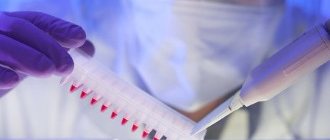pharmachologic effect
Verapamil blocks the transmembrane entry of calcium ions (and possibly sodium ions) into the cells of the myocardial conduction system and the smooth muscle cells of the myocardium and blood vessels. The antiarrhythmic effect of verapamil is probably due to its effect on the “slow” channels in the cells of the cardiac conduction system.
The electrical activity of the sinoatrial and atrioventricular nodes largely depends on the entry of calcium into the cells through “slow” channels. By inhibiting this calcium entry, verapamil slows atrioventricular conduction and increases the effective refractory period in the AV node in proportion to heart rate. This effect leads to a decrease in the ventricular rate in patients with atrial fibrillation and/or atrial flutter. By stopping the reentry of excitation in the atrioventricular node, verapamil can restore correct sinus rhythm in patients with paroxysmal supraventricular tachycardia, including Wolff-Parkinson-White syndrome. Verapamil has no effect on conduction along additional pathways, does not affect the unchanged atrial action potential and intraventricular conduction time, but reduces the amplitude, depolarization rate and conduction in altered atrial fibers. Verapamil does not cause spasm of peripheral arteries and does not change the total calcium content in the blood plasma. The maximum therapeutic effect is observed 3 to 5 minutes after a bolus intravenous administration of verapamil.
Note!
Description of the drug Verapamil-Darnitsa solution d/in. 2.5 mg/ml amp. 2ml No. 10 on this page is a simplified author’s version of the apteka911 website, created on the basis of the instructions for use.
Before purchasing or using the drug, you should consult your doctor and read the manufacturer's original instructions (attached to each package of the drug). Information about the drug is provided for informational purposes only and should not be used as a guide to self-medication. Only a doctor can decide to prescribe the drug, as well as determine the dose and methods of its use.
Pharmacokinetics
Metabolized during first pass through the liver. Binds to plasma proteins by 90%. Penetrates through the blood-brain and placental barrier and into breast milk (in small quantities).
Rapidly metabolized in the liver by N-dealkylation and O-demethylation to form several metabolites. The accumulation of the drug and its metabolites in the body explains the increased effect during a course of treatment.
The most significant metabolite is the pharmacologically active norverapamil (20% of the antihypertensive activity of verapamil). The metabolism of the drug involves isoenzymes CYP3A4, CYP3A5 and CYP3A7. The half-life is two-phase: about 4 minutes - early and 2-5 hours - late. Excreted by the kidneys 70% (unchanged 3-5%), with bile 25%. Not excreted during hemodialysis.
Under conditions of intravenous administration, the antiarrhythmic effect develops within 1-5 minutes (usually less than 2 minutes), hemodynamic effects - within 3-5 minutes. The antiarrhythmic effect lasts about 2 hours, the hemodynamic effect lasts 10-20 minutes. Excreted mainly by the kidneys and feces (about 16%). Penetrates into breast milk and passes through the placenta. Rapid intravenous administration causes maternal hypotension leading to fetal distress. With prolonged use, clearance decreases and bioavailability increases. Against the background of severe liver dysfunction (liver failure), plasma clearance decreases by 70% and the half-life increases to 14-16 hours.
Indications for use
For the treatment of supraventricular tachyarrhythmias, including:
- restoration of sinus rhythm in paroxysmal supraventricular tachycardia, including conditions associated with the presence of additional pathways in Wolff-Parkinson-White (WPW) and Lown-Ganong-Levine (LGL) syndrome;
- control of the frequency of ventricular contractions during atrial flutter and atrial fibrillation (tachyarrhythmic variant), except for cases when atrial flutter or fibrillation is associated with the presence of additional pathways (WPW and LGL syndromes).
Indications
Pills
paroxysmal supraventricular tachycardia;
atrial flutter/fibrillation with rapid AV conduction (except WPW syndrome);
stable angina pectoris;
angina at rest;
vasospastic angina;
post-infarction angina in patients without heart failure in the presence of contraindications to the use of β-adrenergic receptor blockers;
AG.
R-r
paroxysmal supraventricular tachycardia;
atrial fibrillation (except WPW syndrome);
unstable angina in patients with contraindications to the administration of nitrates and/or beta-adrenergic receptor blockers (including vasospastic angina);
AG;
hypertensive crisis.
In children it is used for paroxysmal supraventricular tachycardia.
Contraindications
Hypersensitivity, severe left ventricular (LV) dysfunction, second and third degree atrioventricular block (except in patients with an artificial pacemaker), sick sinus syndrome (bradycardia-tachycardia syndrome) except in patients with an artificial pacemaker, atrial flutter and fibrillation and WPW -syndrome or Lown-Ganong-Levine syndrome (except for patients with a pacemaker), chronic heart failure (except for those caused by supraventricular tachycardia, subject to treatment with verapamil), severe arterial hypotension (systolic blood pressure less than 90 mm Hg) or cardiogenic shock, ventricular tachycardia with wide QRS complexes (>0.12 sec.), simultaneous use with colchicine, with intravenous beta-blockers, use of disopyramide 48 hours before and 24 hours after the administration of verapamil, pregnancy, lactation.
Overdose
It manifests itself as significant arterial hypotension, cardiac arrhythmias, which lead to the development of shock and cardiac arrest, dizziness, stupor, decreased potassium levels in the blood, hyperglycemia, metabolic acidosis, hypoxia, cardiogenic shock (with pulmonary edema), decreased renal function and convulsions.
Regardless of the time elapsed after taking verapamil, gastric lavage is performed.
Indirect cardiac massage, artificial respiration, defibrillation, and cardiac stimulation are performed. Hemodialysis is not performed. Hemofiltration and plasmapheresis are required.
The specific antidote is calcium. 10–20 ml of 10% calcium gluconate solution is administered intravenously. If necessary, repeat or additionally carry out drip infusion.
In the case of AV block (II and III degree), sinus bradycardia, cardiac arrest - atropine, isoprenaline, orciprenaline or cardiac pacing.
Elimination of arterial hypotension - dopamine (at a dose of up to 25 mcg/kg/min), dobutamine (at a dose of up to 15 mcg/kg/min) or norepinephrine; in the early stages - administration of Ringer's solution or 0.9% NaCl. Required concentration of Ca2+ in blood plasma: the upper limit of normal or slightly above normal.
special instructions
Arterial hypotension, decreased neuromuscular transmission (for example, Duchenne muscular dystrophy), atrioventricular (AV) block I stage, bradycardia, idiopathic hypertrophic subaortic stenosis (IGSS), hypertrophic obstructive cardiomyopathy, simultaneous use with cardiac glycosides, quinidine, flecainide, ritonavir , lovastatin, simvastatin, atorvastatin; elderly age, age under 18 years (efficacy and safety of use have not been studied), chronic heart failure, liver and/or kidney failure
Directions for use and doses
Administer intravenously only, slowly, over at least 2 minutes, with continuous monitoring of the electrocardiogram, heart rate and blood pressure.
In elderly patients, administration is carried out over at least 3 minutes to reduce the risk of unwanted effects.
To relieve paroxysmal cardiac arrhythmias or hypertensive crisis, 2-4 ml of a solution of 2.5 mg/ml (5-10 mg) is administered intravenously, in a stream (under ECG and blood pressure control). If there is no effect, repeated administration after 30 minutes at the same dose is possible. A verapamil solution is prepared by diluting 2 ml of a 2.5 mg/ml solution of the drug in 100-150 ml of 0.9% sodium chloride solution.
Application
Pills. the dose is selected individually. The tablet is taken whole, while sitting or standing, during or immediately after a meal, with a sufficient amount of liquid.
Adults and adolescents weighing 50 kg
Therapy of coronary artery disease, paroxysmal supraventricular tachycardia, atrial fibrillation: daily dose - 120-480 mg (in 3-4 doses).
Hypertension therapy: daily dose - 120–360 mg (in 3 divided doses).
Children (exclusively for cardiac arrhythmias)
6 years: daily dose - 80-120 mg (in 2-3 doses).
6–14 years: daily dose – 80–360 mg (in 2–4 doses).
If renal function decreases, verapamil hydrochloride should be used with caution.
If liver function decreases, the use of verapamil hydrochloride is started with caution, with low doses (40 mg 2-3 times a day at the initial stage).
Discontinuation of the drug after long-term treatment should be gradual.
The duration of treatment is determined individually by the doctor.
The solution is administered intravenously slowly (≥2 min; under the supervision of medical personnel, with ECG and blood pressure monitoring).
If verapamil is administered intravenously to a patient with unstable angina as initial treatment, it is necessary to switch to oral administration of the drug as quickly as possible.
In adults and adolescents weighing 50 kg, the starting dose of Verapamil-Darnitsa, solution for injection, is 2 ml; if necessary, another 2 ml is administered after 5–10 minutes.
Further drip administration over 1 hour of 2–4 ml of Verapamil-Darnitsa, diluted in 0.9% NaCl solution or 5% glucose solution (pH 6.5) is possible.
With intravenous administration, the average daily dose: ≤100 mg verapamil hydrochloride.
If liver function decreases, the use of verapamil hydrochloride should be started with caution.
Children. In case of tachycardia associated with heart failure, digitalization is necessary before intravenous administration.
Dose of Verapamil-Darnitsa, solution for injection, in children:
newborns - 0.3–0.4 ml;
infancy - 0.3–0.8 ml;
1 year - 5 years - 0.8–1.2 ml;
6–14 years old – 1–2 ml.
For children 1 year of age, Verapamil-Darnitsa, solution for injection, is administered only for health reasons in the absence of other treatment options.
The use of Verapamil-Darnitsa is canceled immediately after the result occurs.
Side effect
Often -1-10%; sometimes - 0.1-1%; rarely - 0.01-0.1%; very rarely - less than 0.001%, including isolated cases.
From the cardiovascular system: severe bradycardia (less than 50 beats/min), marked decrease in blood pressure, development or worsening of heart failure, tachycardia; rarely possible development of angina, up to myocardial infarction (especially in patients with severe obstructive lesions of the coronary arteries), arrhythmia (including ventricular fibrillation and flutter); with rapid administration - third degree atrioventricular block, asystole, collapse.
From the central nervous system: dizziness, headache, fainting, anxiety, lethargy, fatigue, asthenia, drowsiness, depression, extrapyramidal disorders (ataxia, mask-like face, shuffling gait, stiffness of arms or legs, trembling of hands and fingers, difficulty swallowing ), a single case of the development of paralysis (tetraparesis) under the condition of combined use of verapamil and colchicine.
From the digestive system: nausea, constipation (rarely - diarrhea), gum hyperplasia (bleeding, soreness, swelling), increased appetite, increased activity of liver transaminases and alkaline phosphatase.
Allergic reactions: skin itching, rash, facial skin flushing, exudative erythema multiforme (including Stevens-Johnson syndrome).
Other: weight gain, very rarely - agranulocytosis, gynecomastia. hyperprolactinemia, galactorrhea, arthritis, transient loss of vision against the background of maximum concentration, pulmonary edema, asymptomatic thrombocytopenia, peripheral edema (swelling of the ankles, feet and legs).
Overdose
Symptoms: marked decrease in blood pressure, sinus bradycardia, turning into atrioventricular block, sometimes asystole, hyperglycemia, stupor, sinoatrial block, metabolic acidosis. There have been reports of deaths due to overdose.
Treatment: supportive symptomatic therapy should be carried out. To increase blood pressure, vasopressor drugs are prescribed, for atrioventricular block - an artificial pacemaker, for asystole - intravenous administration of vasopressor drugs or resuscitation measures. Hemodialysis is not effective.
Interaction with other drugs
Alpha blockers
— Prazosin: an increase in Cmax of prazosin (~40%) does not affect the half-life of prazosin.
— Terazosin: increase in AUC of terazosin (~24%) and Cmax (~25%).
Antiarrhythmic drugs
— Flecainide: minimal effect on the clearance of flecainide in blood plasma (<~10%); does not affect the clearance of verapamil in blood plasma.
- Quinidine: decreased oral clearance of quinidine (~35%).
Drugs for the treatment of bronchial asthma
- Theophylline: decreased oral and systemic clearance of theophylline (~20%). In smoking patients there is a decrease of ~11%.
Anticonvulsants
— Carbamazepine: increased AUC of carbamazepine (~46%) in patients with resistant partial epilepsy.
Antidepressants
— Imipramine: increase in AUC of imipramine (~15%). Does not affect the level of the active metabolite, desipramine.
Hypoglycemic agents
— Glyburide: glyburide Cmax increases (~28%), AUC (~26%).
Antimicrobials
- Erythromycin: possible increase in the concentration of verapamil in the blood plasma.
— Rifampicin: decrease in verapamil AUC (~97%), Cmax (~94%), bioavailability ~92%.
- Telithromycin: possible increase in the concentration of verapamil in the blood plasma.
Antitumor agents
- Doxorubicin: an increase in AUC of doxorubicin (89%) and Cmax (61%) when taking verapamil orally in patients with small cell lung cancer. The administration of verapamil intravenously in patients with progressive neoplasms does not affect the pharmacokinetic parameters of doxorubin.
Barbiturates
— Phenobarbital: increase in oral clearance of verapamil ~5 times.
Benzodiazepines and other tranquilizers
— Buspirone: increase in buspirone AUC, Cmax ~ 3.4 times
— Midazolam: increase in midazolam AUC (~ 3 times) and Cmax (~ 2 times).
Beta blockers
— Metoprolol: increase in metoprolol AUC (~32.5%) and Cmax (~41%) in patients with angina pectoris.
— Propranolol: increase in AUC of propranolol (~65%) and Cmax (~94%) in patients with angina pectoris.
Cardiac glycosides
— Digitoxin: decrease in total clearance (~27%) and extrarenal clearance (~29%) of digitoxin.
— Digoxin: in healthy volunteers, Cmax of digoxin increases by ~45-53%, Css of digoxin by ~42% and AUC of digoxin by ~52%.
Immunological agents
- Cyclosporine: increase in AUC, Css, Cmax of cyclosporine by ~45%.
- Everolimus: plasma levels of everolimus may increase.
- Sirolimus: the level of sirolimus in the blood plasma may increase.
- Tacrolimus: the level of tacrolimus in the blood plasma may increase.
Lipid-lowering drugs (HMG-CoA reductase inhibitors)
- Atorvastatin: the level of atorvastatin in the blood plasma may increase.
- Lovastatin: an increase in the level of lovastatin in the blood plasma is possible.
— Simvastatin: increase in AUC (~2.6 times) and Cmax (~4.6 times) of simvastatin.
Serotonin receptor agonists
— Almotriptan: increase in AUC (~20%) and Cmax (~24%) of almotriptan.
Uricosuric drugs
— Sulfinpyrazone: increased clearance of verapamil (~ 3 times) and decreased bioavailability (~ 60%).
Other
— Grapefruit juice: increase in AUC R- (~49%) and S-(~37%) verapamil and Cmax R- (~75%) and S-(~51%) verapamil. The half-life and renal clearance were unchanged.
— St. John's wort: the AUC of R- (~78%) and S-(~80%) verapamil decreases with a corresponding decrease in Cmax.
Other types of interaction
- Cimetidine: reduces the clearance of verapamil when administered intravenously.
Verapamil, as a drug that is highly bound to plasma proteins, should be used with caution when used simultaneously with other drugs that have a similar ability. When using drugs for inhalational general anesthesia and blockers of “slow” calcium channels, which include verapamil, together, the dose of the drug for inhalational general anesthesia should be carefully titrated until the desired effect is achieved in order to avoid excessive depression of the cardiovascular system. Verapamil may enhance the effect of drugs that block neuromuscular conduction (such as curare-like and depolarizing muscle relaxants). Therefore, the dose of verapamil and/or the dose of drugs that block neuromuscular conduction should be reduced when used simultaneously. Potentially increased neurotoxicity of lithium. Verapamil may also reduce serum lithium levels in patients receiving lithium for a long time. If these drugs are used concomitantly, patients should be closely monitored.
— Prazosin, terazosin: additive antihypertensive effect.
- Ritonavir and others: may inhibit the metabolism of verapamil, leading to
antiviral (HIV) to increase its concentration in the blood plasma, therefore
verapamil dosage should be reduced.
- Carbamazepine: an increase in the level of carbamazepine in the blood plasma and the appearance of adverse reactions such as diplopia, headache, ataxia or dizziness.
- Rifampicin: may reduce the antihypertensive effect of verapamil.
- Colchicine: is a substrate for the isoenzymes CYP3A and P-glycoprotein, which in turn inhibit the metabolism of verapamil. Therefore, when used simultaneously with verapamil, the concentration of colchicine in the blood may increase significantly.
- Sulfinpyrazone: may reduce the antihypertensive effect of verapamil.
— Acetylsalicylic acid: increased bleeding. (aspirin)
— Antihypertensive drugs: enhanced antihypertensive effect. diuretics, vasodilators
Lipid-lowering drugs. HMG-CoA reductase inhibitors (statins)
- Simvastatin/lovastatin/atorvastatin: Concomitant use with verapamil may cause atorvastatin to increase serum concentrations of simvastatin or lovastatin. In patients receiving verapamil, treatment with HMG-CoA reductase inhibitors (i.e. simvastatin, atorvastatin, lovastatin) should be started with the lowest possible doses and then increased. If it is necessary to prescribe verapamil to patients already receiving HMG-CoA reductase inhibitors, it is necessary to review and reduce their doses according to the concentration of cholesterol in the blood serum. Similar tactics should be followed when concomitantly prescribing verapamil with atorvastatin, although there is no clinical data confirming their interaction.
- Fluvastatin, pravastatin: not metabolized by CYP3A4 isoenzymes,
and rosuvastatin, therefore their interaction with verapamil is least likely. Although intravenous verapamil has been used in conjunction with digitalis drugs without serious side effects, given that these drugs slow AV conduction, monitoring of patients is necessary for timely detection of AV block or severe bradycardia.
- Quinidine: the development of arterial hypotension is possible with the combined use of quinidine and verapamil intravenously, so this combination of drugs must be used with caution.
Beta blockers: Concomitant intravenous administration of verapamil and beta blockers has resulted in serious side effects (severe bradycardia), especially in patients with cardiomyopathy, heart failure or recent myocardial infarction. Beta blockers should be prescribed several hours before or several hours after verapamil. Disopyramide should not be given 48 hours before or 24 hours after verapamil. When verapamil and flecainide are used together, an additive effect is possible with a decrease in myocardial contractility, prolongation of AV conduction and myocardial repolarization.


